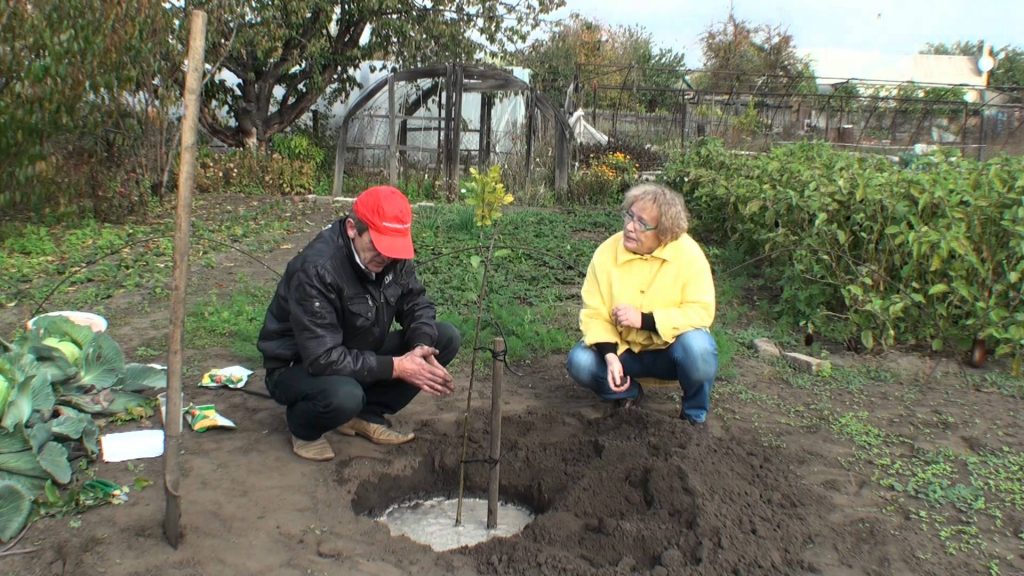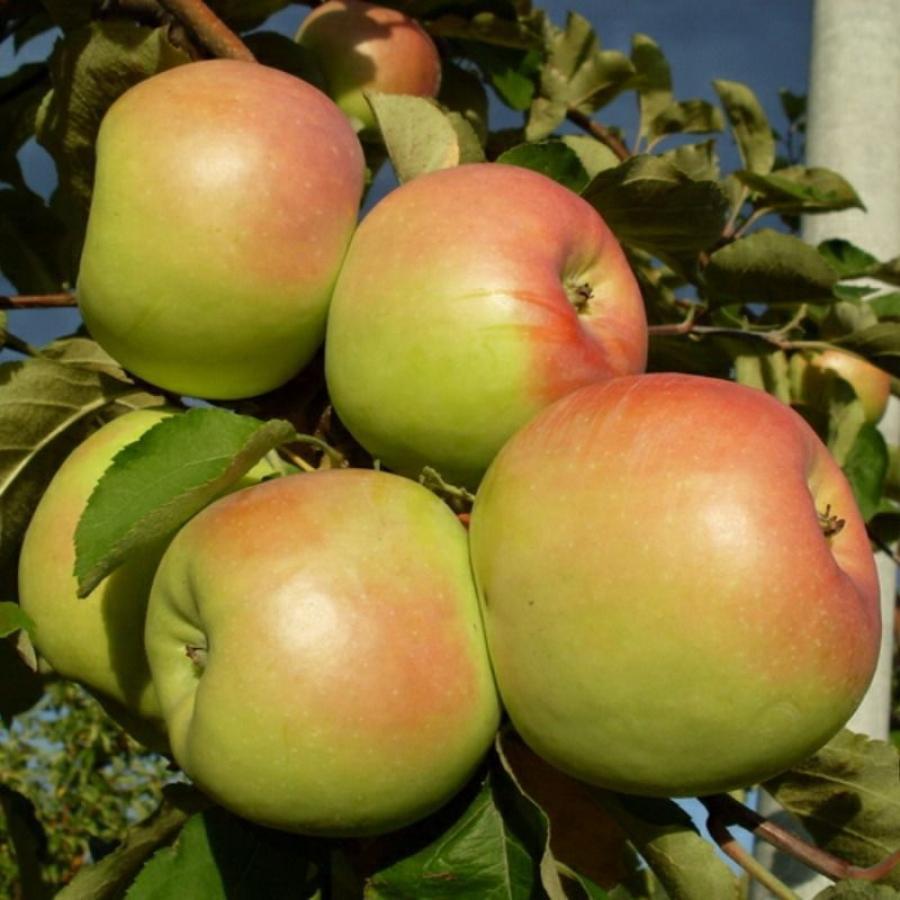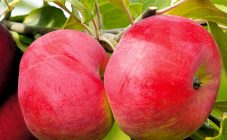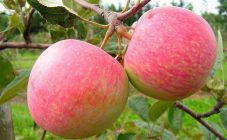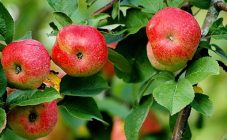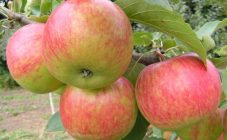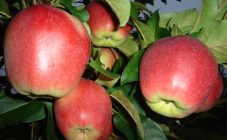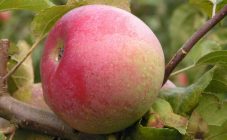Content:
The apple tree Sinap Orlovsky is a late winter variety, which was obtained in 1955 thanks to a group of Russian breeders led by E.N. Sedova. The culture is prized for its unusual taste and long shelf life.
The Sinap variety is divided into two types - Severny and Orlovsky. The first was obtained by S.I. Isaev using pollination of seeds of Kandil-Kitayka in 1927. The Orlovsky variety was bred from Severny, therefore it has identical taste and has a high yield.
Description of the apple tree Sinap Orlovsky
Trees of this type have massive dimensions, so if you are going to plant them on the site, you will have to allocate enough space. The height of an adult apple tree can reach from 3 to 5 m. The apple tree has sweeping branches and a wide crown. Wide branches are not densely located on the tree, perpendicular, which will greatly facilitate apple picking. The bark of the trunk and branches is dark brown.
The leaves are large enough, pointed at the edge. The color of the leaves may depend on the amount of sunlight. They can be either bright or dark green.
Fruit characteristics
Sinap apples are round or oblong in shape, while the top of the fruit is flattened. The weight of the apple can vary from 120-150 g. The peel is firm, smooth, with a glossy bloom. At maturity, the skin has a yellow-green tone, but after a couple of weeks it becomes yellow-golden. The side facing the sun has a delicate appetizing red blush.
The pulp is juicy, light green in color, with a loose structure.
Rules for planting seedlings
As a rule, autumn time is chosen for planting apple tree seedlings. Planting is carried out in early September or mid-October. However, you can plant trees in the spring, at the beginning of April. But it is important that the threat of frost passes, otherwise the seedlings simply will not take root.
Planting for the Sinap variety is recommended to be made on loamy or sandy loam soils with high air and water permeability. The soil that is used for planting an apple tree must contain the required amount of calcium. Its lack can negatively affect the palatability of the fruit. They will begin to be amazed by the bitter pitting.
Main landing features:
- 14 days before planting, you need to prepare holes for seedlings;
- the holes should go no more than 70 cm deep, the diameter should be 1 m;
- the pit before planting trees must be loosened;
- the bottom of the pit must be laid out with fragments of brick or expanded clay. This provides additional drainage;
- fertile land must be mixed with rotted manure, as well as wood ash;
- potassium sulfate (40g) and superphosphate (80g) are poured into the finished soil. Mix the finished mixture thoroughly. Before planting, the mixture is poured into the holes, covering 1/3 of its part;
- after the fertilizer is poured, the earth is poured on top to form a slide 15-20 cm high.
After that, carefully place the seedling in the hole. Install a support near it and tie up the plant.The height of the peg should be at least 70 cm. The roots of the plant should be straightened, not allowing them to get tangled, then, sprinkling with earth, they are tamped. Once the seedling is planted, it is filled with water. A young tree needs up to 3 buckets of water.
Care features
Despite the fact that this kind of apple tree is unpretentious in care, it is worth paying attention to some points so that the tree will bring even more harvest.
Pruning branches
- Once the young trees are planted, a third of the branches should be cut off.
- The next year, in springtime, the branches are removed so that only three tiers remain.
- In the future, trimming is carried out so that only one main conductor remains. It is imperative to remove dry and damaged branches.
Watering features
In order for the tree to bear fruit well and give a large harvest, it is important to remember about proper watering:
- In the spring and summer, trees are watered at least 5 times a month.
- Young trees should be poured 2-3 buckets of water.
- After each watering, it is necessary to loosen the soil to distribute moisture evenly.
Disease resistance
Apple trees Sinap are sick with powdery mildew or scab. To avoid them, you should provide the plant with maximum protection and care.
Protection and prevention measures:
- It is necessary to constantly monitor the condition of the branches and the presence of damage to the bark.
- Prune dry branches and affected areas.
- After removing the pruning site, young trees are covered with chalk, and mature trees - with a lime solution.
- After the harvest is completely harvested, the tree crowns are treated with a 3-5% solution of copper sulfate.
- In early spring, before buds bloom, the tree should be sprayed with Fitosporin M.
If a moth appears on the apple tree, wormwood tincture is used to fight. Add 25 ml of solution to 10 liters of water and spray the trees. This procedure is carried out 4-5 weeks before harvest.
Advantages and disadvantages of the variety
According to numerous reviews of experienced gardeners, the variety has a number of positive qualities.
- The apple tree Sinap Orlovsky gives a stable harvest. From one mature tree, you can get from 130 to 200 kg of apples.
- Early maturity. After 3 years, the first crop can be harvested.
- High level of winter hardiness. The variety is excellent for planting in northern regions.
- Long shelf life and transportability.
- Excellent taste of the fruit.
Minuses:
- Due to its large size, the plant takes up a lot of space on the site.
- Rather weak resistance to disease.
- The variety is sensitive to a lack of calcium in the soil.
- Self-infertility
- Since the variety is self-fertile, other pollinating trees need to be planted nearby.
For such a Sinap variety, the following varieties will be the best pollinators: Northern Sinap, Slavyanka, Antonovka ordinary, Zhigulevskoe, Welsey. If pollinators do not grow in the area next to the apple tree, the amount of the crop can be reduced to 40%
Of course, in order to get a good harvest, you need to make some effort, as well as follow the rules of planting and further care, and then in the future it will be possible to grow a beautiful apple orchard.

